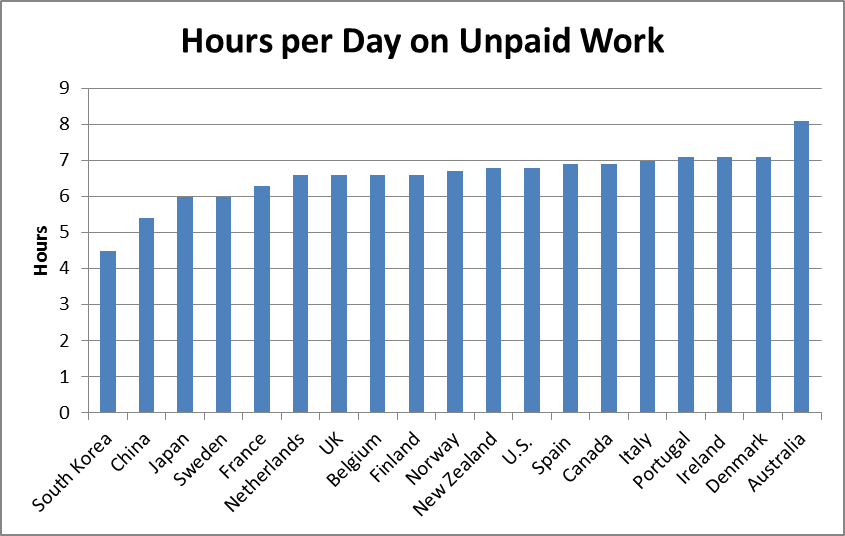February 23, 2016
Claire Cain Miller had an interesting Upshot piece about differences in the way men and women divide child care and other unpaid household labor across countries. Some countries, notably the Nordic countries and the United States have made substantial progress in lessening the gap between women and men’s hours, although women still do substantially more unpaid work even in these countries (over 50 percent more in the United States). Other countries on the list, mostly those in Asia and southern Europe have done much worse by this measure, still having ratios of more than two to one.
While this is a very important issue which I would not want to trivialize, I couldn’t help but notice the substantial differences in total hours per day of unpaid labor reported across countries. The figure below sum the hours reported in each country for men and women.

At low end is South Korea, where the total reported hours of unpaid work are just 4.5 per day. Next in line is China at 5.4 hours, and then Japan at 6.0 hours. The big outlier at the other extreme is Australia at 8.1 hours per day, a full hour below Denmark, where total hours are 7.1 per day. The United States comes in close to the average at 6.8 hours per day.
These differences are striking because it implies that people in some countries do much less unpaid work than others. Taking the extremes, people in Australia put in over 80 percent more unpaid hours than people in South Korea. The difference comes to 25 hours a week or more than 1300 hours a year. That’s real time.
It’s not clear what to make of these differences. It may reflect differences in the way the surveys are conducted so that the numbers are not directly comparable across countries. (I will happily be enlightened by readers familiar with these data.) There are some obvious reasons to expect differences.
In the United States, people work longer hours and get higher income than people in Europe. There is a simple story where we might expect that the higher income is used to avoid household work. People in the United States should be better able to afford convenience foods or eating out and finding other ways to use their greater income to avoid doing unpaid labor.
However that story doesn’t seem to fit the data. People in the United States report spending more time on unpaid work than do people in most of the wealthy European countries included in Miller’s sample.
There is another obvious explanation: the three countries at the bottom end of the table, South Korea, China, and Japan, all have very low birth rates. This presumably means that parents have to spend less time doing unpaid child care work.
But then we get to France. According to the CIA Factbook, French women on average have 2.08 children, compared to 1.87 in the United States. Yet the French spend an average of 0.5 less hours per day on unpaid labor. That translates into 3.5 fewer hours per week and 183 fewer hours per year. Part of the explanation is likely the relatively good child care system in France. But in any case, it looks like the French are doing pretty well in preserving their leisure time.
Sweden also seems to be doing quite well with an even larger gap in unpaid labor of 0.6 hours per day. Sweden also has a higher fertility rate than the United States, but the difference is small, 1.88 children per woman compared to 1.87 children per woman in the United States.
Anyhow, I’m sure people have done careful analyses of unpaid work hours across countries, but the gap between the countries on this list does seem surprising. Just as with our paid work, we should want our unpaid work to be as productive as possible, and by these crude numbers, it doesn’t look the United States is doing very well.







Comments